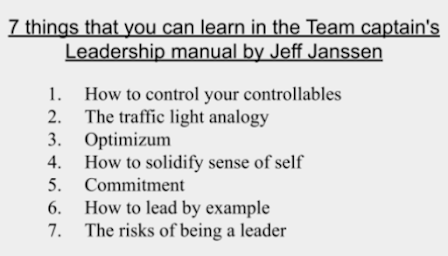Captaincy should be more than a popularity contest. The local volleyball team process includes support of your teammates and coaches, endorsement from their teachers and school leadership. There are no "knuckleheads."
What roles do captains fill?
- Leadership. Model excellence at all times in all venues.
- Communication. Comms come down and go up to coaches.
- Reliability. Fill whatever roles are necessarily.
- Representation. "Represent" when you help with set up and clean up, not only during pre-game and game action. You are an ambassador for the team in school and in the community.
- Attitude. Be positive, energetic, and poised. "This is not your first rodeo."
Jeff Janssen’s Team Captain’s Leadership Manual is a foundational guide for developing athlete-leaders in team sports. Grounded in the idea that leadership is influence, the book equips captains with the mindset, skills, and responsibilities necessary to become effective leaders who model excellence and elevate their teammates.
Core Concepts
Leadership Is a Skill
Janssen treats leadership as a trainable skill, not an innate trait. Captains are not just figureheads—they are active agents who can develop communication, credibility, and character.The Six Types of Team Captains
Janssen outlines six leadership styles:The Vocal Leader – energizes and communicates directly.
The Performance Leader – leads by example in practice and games.
The Locker Room Leader – maintains morale and team unity.
The Social Leader – influences culture outside the sport.
The Organizational Leader – handles team logistics and preparation.
The Servant Leader – focuses on serving teammates above self.
Great captains integrate several of these roles, knowing when and how to step up or support.
The Captain's Commitment Levels
Janssen stresses that captains must first commit to personal excellence before leading others. This includes:Living the team’s values.
Being accountable and coachable.
Consistently working hard and staying positive.
From there, leaders build trust and influence teammates toward shared goals.
Communication and Conflict
The manual prepares captains to handle:Honest team talks.
Conflict resolution (including confronting teammates constructively).
Acting as a bridge between coaches and players.
Leading by Example and Energy
Captains are cultural carriers. They must consistently:Uphold team standards.
Bring energy in adversity.
Celebrate effort and hold teammates accountable.
The Leadership Ladder
Janssen uses a “Leadership Ladder” to help athletes grow from basic leadership (leading by example) to advanced levels (inspiring and developing others). This progression demystifies the leadership journey and shows that anyone willing to do the work can climb.
Practical Tools
The manual includes:
Self-assessments and reflection tools.
Team meeting outlines.
Weekly leadership challenges.
Exercises for co-captain alignment.
It’s designed to be actionable and coach-supported, so teams can bake leadership development into their season.
Bottom Line
Jeff Janssen’s Team Captain’s Leadership Manual is not just a motivational text—it’s a hands-on workbook for building leaders who:
Influence with purpose,
Model excellence daily,
And lift the culture of their teams.
- Distractions. "Never be a distraction." Distractors disrupt the team internally or externally through actions that bring the team down.
- Social media abuse. If you're on social media, lift people up. Don't give opponents motivation.
- Never 'punch down'. Everyone matters. Coach Mike Krzyzewski likens a team to a fist. Punching with only 3 or 4 fingers is weakness.
- Bad attitudes. Excel in your role. If not playing as much as you'd like, work harder and take responsibility. "You own your paycheck." Your performance earns minutes, roles, and recognition.
- Negativity. "Don't whine, don't complain, don't make excuses." When opportunity comes, take advantage of it.
Yellow Light - Caution/Transition zone: This represents a warning state where emotions are elevated but the captain still has some control. It's a time to slow down, assess the situation, and make conscious choices about how to respond.
Green Light - Go/Control zone: This represents a calm, composed state where the captain can think clearly and take appropriate leadership action.
The analogy helps team captains develop emotional intelligence and self-regulation skills, teaching them to recognize their emotional state and respond appropriately rather than react impulsively. This is particularly important for captains who need to maintain composure during high-pressure situations and model good behavior for their teammates.
A similar analogy comes from James Kerr's great "Legacy" referring to the "Blue head" of calmness and stability versus the "Red head" of anger and loss of control.
